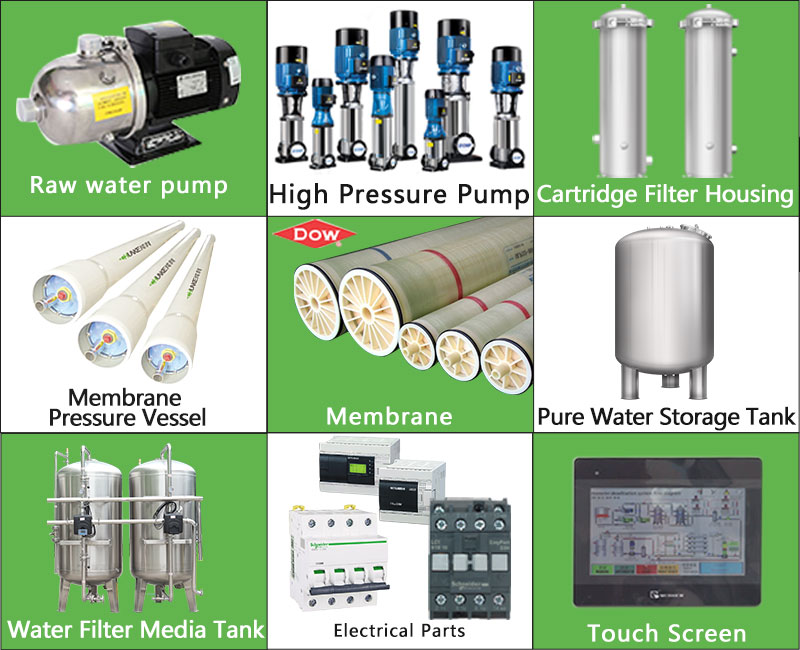How to filter seawater? The best seawater filter
Seawater covers more than 70% of the Earth's surface, but due to its high salinity and mineral content, it is not practical to drink directly or use for most industrial and agricultural purposes. Therefore, seawater filtration has become an important technology that can not only provide clean freshwater resources but also meet the growing water needs of mankind.
This article will explore the feasibility of seawater filtration in detail and introduce the most effective seawater filters currently available.

Can seawater be filtered?
The concept of seawater filtration is not new, but its technical difficulty and cost make it a challenge. The salt, microorganisms, organic matter and other minerals in seawater make it more difficult to treat than fresh water. Therefore, seawater filtration is not just a simple removal of impurities, but also involves a complex desalination process.
The challenge of high salinity
Seawater contains about 3.5% salt, mainly composed of sodium chloride (NaCl). To remove these salts from the water, complex and energy-consuming technologies are required. Traditional filtration methods, such as sand filtration and carbon filtration, cannot effectively remove salt dissolved in water. Therefore, the core technology for treating seawater lies in desalination, that is, separating dissolved salts from water.
Microorganisms and organic matter
In addition to salt, seawater also contains a large amount of microorganisms and organic matter, such as algae, plankton, and the remains of marine plants. These substances will not only pollute the filtration equipment, but may also have an adverse effect on the water quality. Therefore, in the process of seawater filtration, removing these impurities is also an important task.
Economic cost and energy consumption
Another major challenge of seawater filtration is the high economic cost and energy consumption. Whether it is reverse osmosis technology or distillation technology, a lot of energy is required to treat seawater, which makes seawater filtration an expensive solution. Therefore, despite the abundant seawater resources, how to filter in an economical and efficient way remains an important topic.

What are the main technologies for seawater filtration?
Before understanding seawater filters, we need to understand the main seawater filtration technologies at present. These technologies can be roughly divided into physical filtration, chemical filtration, and desalination technology.
Physical filtration
Physical filtration is the first line of defense in seawater treatment and is usually used to remove larger particles and suspended matter. The following are some common physical filtration methods:
● Coarse filtration: Remove large particles such as sand, shell fragments and other impurities from seawater by using a coarse filter or grid. This is the most basic filtration step and is usually used to protect subsequent filtration equipment.
● Microfiltration and ultrafiltration: These filtration technologies use finer membranes to remove fine particles, colloids, and some microorganisms from seawater. Although they cannot remove dissolved salts, they can significantly reduce the concentration of suspended solids in the water.
Chemical filtration
Chemical filtration is often used to remove dissolved organic matter and heavy metals from water. Here are some common chemical filtration methods:
● Activated carbon filtration: Activated carbon filters can adsorb organic matter and odor substances in water. Although it cannot remove salt, it can improve water quality and reduce the amount of impurities in water.
● Ion exchange: Chemical filters can remove some dissolved salts and heavy metals from seawater through ion exchange resins. However, this method is usually used to treat smaller amounts of water and is not economical for large-scale seawater desalination.
Desalination technology
Desalination is the most critical step in seawater filtration. There are two main methods: reverse osmosis and distillation.
● Reverse osmosis (RO): Reverse osmosis is currently the most common seawater desalination technology. It uses high pressure to pass seawater through a semi-permeable membrane. Salts and other dissolved substances are retained on one side of the membrane, while pure water permeates through the membrane. Reverse osmosis systems can effectively remove salt and other impurities from seawater to produce high-quality fresh water.
● Distillation: Distillation is the process of heating seawater to boiling, and the evaporated water vapor condenses into fresh water, leaving behind salt and other impurities. Although this method is effective, it consumes a lot of energy, so it is usually used in resource-rich areas or emergency situations.

What is the best seawater filter?
When choosing a seawater filter, you need to consider factors such as treatment efficiency, operating costs, maintenance requirements, and the life of the equipment. Here are several seawater filtration devices that are widely used and effective on the market today.
Reverse Osmosis (RO) Seawater Filters
Reverse osmosis seawater filters are currently the most commonly used seawater filtration equipment. Its core technology is based on reverse osmosis membranes, which apply high pressure to force water molecules through the membrane, leaving behind salt and other impurities. Reverse osmosis systems can provide high-quality fresh water, which is very suitable for use in homes, ships, and offshore platforms.
Advantages of reverse osmosis (RO) seawater filters:
● Efficient desalination: Reverse osmosis membranes can remove more than 99% of salt and most soluble impurities.
● Easy operation: Reverse osmosis systems have a high degree of automation, simple daily operations, and relatively low maintenance requirements.
● Modular design: Suitable for different scales, from small household equipment to large industrial units.
Disadvantages of reverse osmosis (RO) seawater filter:
● High energy consumption: Due to the need for high-pressure pumps, the energy consumption of reverse osmosis systems is high, especially when treating large amounts of seawater.
● Pretreatment required: In order to protect the reverse osmosis membrane, seawater usually needs to be pretreated to remove suspended matter and large particle impurities.
Distilled seawater filter
Distilled seawater filter uses the principle of heating seawater and condensing steam to separate salt and impurities from seawater. Although distillation technology has a long history, modern distillation equipment is more efficient and has advantages in certain specific occasions.
Advantages of distilled seawater filter:
● Wide applicability: Distillation technology does not require high water quality and can handle high salinity and heavily polluted water sources.
● High water quality: The distilled water is almost free of salt and impurities, very pure, suitable for drinking or other high-demand uses.
● No membrane loss: Unlike reverse osmosis systems, distillation does not require the use of membranes, so there is no problem of membrane wear and replacement.
Disadvantages of distilled seawater filter:
● High energy consumption: Distillation requires heating water, so the energy consumption is very high and usually requires a large amount of energy supply.
● Large equipment size: Distillation equipment is usually large and not suitable for use in places with limited space.

Electrodialysis (ED) seawater filter
Electrodialysis uses an electric field to allow charged ions to pass through a selective membrane to remove ions from seawater, thereby achieving desalination. Electrodialysis equipment is usually used for water source treatment with medium and low salinity, but it is also used in seawater filtration.
Advantages of electrodialysis (ED) seawater filter:
● Low energy consumption: Compared with reverse osmosis and distillation, electrodialysis has relatively low energy consumption, especially when treating low-salinity water.
● Easy to control: Electrodialysis equipment can control the degree of desalination by adjusting the electric field strength to meet different water quality requirements.
● Long equipment life: Since it does not involve heating or high-voltage operation, electrodialysis equipment has a relatively long service life and low maintenance cost.
Disadvantages of electrodialysis (ED) seawater filter:
● Limited applicability: Electrodialysis is not as effective as reverse osmosis in treating high-salinity seawater, and needs to be used in combination with other technologies.
● High equipment complexity: Electrodialysis systems require precise control and monitoring, and are difficult to operate.
Nanofiltration (NF) seawater filter
Nanofiltration is a filtration technology between microfiltration and reverse osmosis, which can remove divalent ions and most organic matter from seawater. The pore size of the nanofiltration membrane is larger, so the energy consumption is lower than that of reverse osmosis, which is suitable for specific seawater treatment needs.
Advantages of nanofiltration (NF) seawater filter:
● Low energy consumption: Due to the large pore size of the nanofiltration membrane, the pressure required for water to pass through is lower, and the energy consumption is lower than that of reverse osmosis.
● Retain minerals: Nanofiltration can remove harmful substances while retaining some beneficial minerals, making the water quality more suitable for drinking.
● Versatility: Nanofiltration equipment can treat seawater, brackish water and other different water sources, and has strong adaptability.
Disadvantages of Nanofiltration (NF) Seawater Filters:
● Limited desalination effect: Nanofiltration membranes cannot remove all salt and are usually used for partial desalination or in combination with other technologies.
● Narrow application range: Suitable for occasions with low water quality requirements, such as industrial water treatment.






